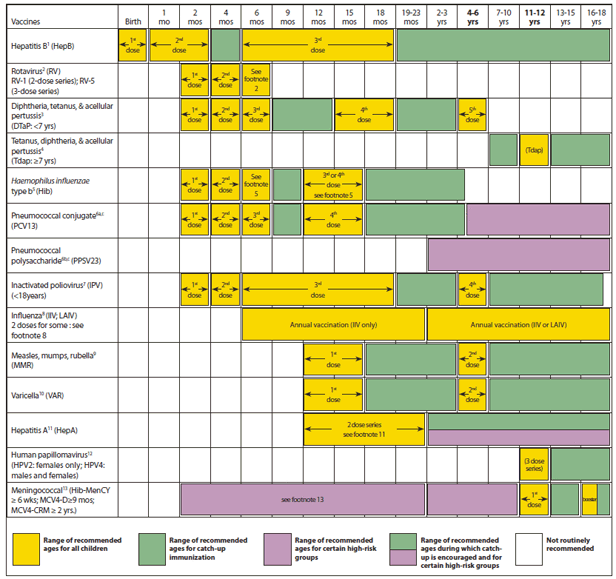FA16 Immunization Module’s Updates
Timing/spacing of Vaccinations in Infants
Adhering to the recommended immunization schedule for children under the age of 18 that is approved and published by the Advisory Committee on Immunization Practices (ACIP), a group under the umbrella of Centers for Disease Control and Prevention (CDC), is very important for a child's health. Appropriately timing and spacing vaccinations as per the guidelines ensures that the vaccine produces an optimal immune response. The dosage and frequency of which to administer vaccinations have been determined through clinical trials.
Infants receive passive immunity from their mother during the final months of pregnancy, at which time the antibodies the mother has can travel across the placenta. This allows the infant to have the some antibodies as their mother, and provides protection against various diseases, including measles and rubella, for up to a year after birth. This is important because most vaccines, with the exception of Hepatitis B, are generally not administered to infants before they reach an age of six weeks. In line with this, the minimum age for Dose 1 of many vaccines, including TDaP, rotovirus, Hib, Pneumococcal, and Inactivated poliovirus is six weeks. These first dose of these vaccines is recommended to be administered at the age of 2 months, followed by a minimum interval of four weeks before the second administration at the age of 4 months. Many of the immunizations on the recommended schedule require multiple doses, usually two or more, in order for the immune system to produce an "adequate and persisting antibody response" (1). If vaccines are administered sooner than the recommended minimal interval, the immune response to the second dose will be inadequate. The first dose of other vaccines like Measles, mumps, rubella (MMR) and Varicella (VAR), are not administered until the age of 12 months.
There are exceptions under which vaccines can be administered sooner that the recommended minimal intervals or sooner than the minimal age. If the infant develops measles before the age of 12 months, then the measles vaccine can be administered. However, this administration is not considered to be a first dose, and the first dose must be appropriately given when the child reaches the age of 12 months. Furthermore, a second exception can be made when its a matter of a few days, specifically up to 4 days, before the recommended minimums.
(1) CDC General Rules of Immunization
(2) http://www.cdc.gov/vaccines/hcp/admin/storage/providers-role-vacc-admin-storage.html
(3) http://www.cdc.gov/vaccines/schedules/downloads/child/0-18yrs-child-combined-schedule.pdf
(4) http://www.immunize.org/askexperts/scheduling-vaccines.asp
(5) Image: http://www.cdc.gov/mmwr/preview/mmwrhtml/figures/su6201a2f1.gif



The table you provided was surprising to me. I had no idea there were so many vaccinations that needed to be done at one time, and needed to be repeated so often. I agree with @Jonathan Knisley that this presents an incredible logistical challenge for new parents. Additionally, the cost of so many shots and recurring doctor visits must be staggering, especially so soon after the bill comes in for the trip to the hospital for the birth of the baby. The financial concern must be a factor which may block some people for immunizing their children, and even if insurance is available, may cause anxiety for parents in lower socioeconomic classes.
The number of vaccinations and the staggered timing of many of them probably presents quite a challenge to new parents. With everything else going on with having a new baby at home, it certainly illustrates the need for good record-keeping and also the role of the pediatrician's office in making sure things are going according to plan. I have many friends currently with newborns and they seem overwhelmed. This is just one more thing to keep straight, but with good teamwork between parents and doctors it can be done.